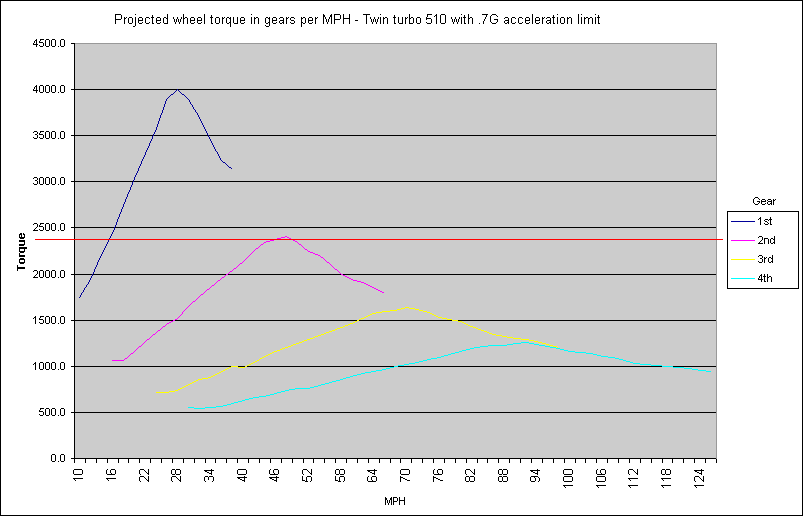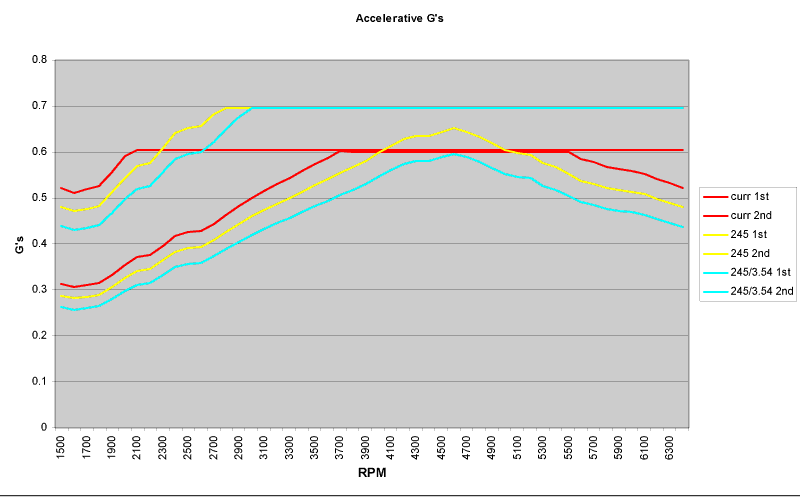Project "Fiat V-Spec" Design notes2, etc |
||||||||||||||||||||||||||||
FV-S Page 1 / FV-S Page 2 / FV-S Page 3 / Engine pictures / Design notes |
||||||||||||||||||||||||||||
Complex math and geekage |
||||||||||||||||||||||||||||
|
Since I'm building a
street/track day car, I'm concerned about "usable power" as the less
feathering of the throttle at the middle speeds (35-80mph) the better. The
510 is really a 0-110mph car, as above 110MPH the lousy aerodynamics really
come into play, and I feel at track days 30-80MPH will be very common exit
speeds. The flipside is since I like to be able to use the throttle to steer
the car, I do need extra power for breaking away the rear. Misc. ramblings
follow... So here I am playing with hard numbers. First some known facts. Using G-Tech, the maximum acceleration in G's I can get with the current tires (195/50-15) and suspension is .6G. Since I can engage the clutch in 1st and floor the throttle with no wheelspin (usually), I can assume that 100% of the torque is making it to the ground. This comes to 2033.5 (171ft-lbs * 3.214 1st gear * 3.7:1 axle ratio - we'll leave tire diameter out for now). Since this is also the ragged edge insofar that on some surfaces the tires WILL spin at WOT, I'll round the max number that can get to ground is 2050ft-lbs. Going on the assumption that much wider tires (245mm section width vs 195's) and eventual better rear suspension will move my max G capability to .695G (16% increase), this gives me the ability to send 2378ft-lbs to the ground. Going from 195/50-15 to 245/45-16 tires changes overall gearing, making it almost 10% taller, so RPM@60 goes from 2565 to 2334. Therefore this reduces torque to the road by the same amount (this is also why we ignored tire diameters in our initial math). Let's whip out some dyno
charts. Below is a chart of torque at the wheel using our formulas above.
I'll use a mild TT showing 310hp at the wheel: Next up, we'll throw in MPH views to get a clearer picture of what this really means.
In MPH terms, engaging just off idle and flooring it results in the traction limit being exceeded at 18mph and never coming back until 2nd gear. At 4600rpm in 2nd (46mph) we're again flirting with the traction limit. In the chart above I have not compensated for aerodynamic drag or rolling resistance, it's simply an evaluation of traction limits. One thing I've always thought - until actually doing the math for this project - is simply compensate for too much power by gearing taller. My findings surprised me. I used the TT torque curve and ran 3 scenarios (ignoring aerodynamics for the moment):
Scenario 1) Current tires
and gearing. So we know it's good for .6G maximum accelerative rate. Current
tires/gearing (max .6G)
For those who like charts, here's how it
graphs out... You can see the G's climb until the maximum is reached, and hopefully the driver is skillful enough to keep it right at the limit! Note even the change from 3.7:1 to 3.54:1 moves 2nd gear below the threshold of the skinnier tire.
Here's a speeds in gears chart for the above 3
scenarios (assuming shifting at 6500rpm), and RPM@60 in 5th gear:
So what I found is the extra couple MPH you get the maximum G's in 1st gear doesn't come close to offsetting the lower G's your using in the next gear. So out of curiosity I threw in a 1st gear that would get you to first - in this case, a mega tall 2.4:1 axle ratio. At no time do you achieve the maximum .695G (you do get to .673G), and your average G's launching at 3200rpm (.5G a this point) nets you 4.8 0-60 (no .4 sec penalty for shifting). Avg G's for this run is .584G - lower than the stock tires and it's lower maximum G limit. And at 63mph you're at only .35G in 2nd |
||||||||||||||||||||||||||||


